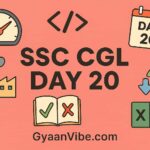GyaanVibe is a focused educational platform dedicated to helping SSC CGL aspirants crack Tier 1 & Tier 2 exam with a strategic, day-wise, and well-structured preparation approach.
SSC CGL Preparation – Day 15
Reasoning: Statement and Conclusion
📘 What is a Statement and Conclusion?
- A statement is a given piece of information or assertion.
- A conclusion is a decision or judgment drawn from the statement.
- You must decide whether the given conclusion logically follows from the statement.
🎯 Types of Questions in SSC CGL:
- Single Statement – Two Conclusions
- Two Statements – One or Two Conclusions
- Cause and Effect-based Conclusions
- Inference and Assumption Blending (Less frequent)
🧠 How to Approach the Question
- Read the statement carefully.
- Evaluate each conclusion independently.
- Avoid assumptions not given in the statement.
- Conclusions must be logically derived and must follow beyond doubt.
📌 Common Phrases & Their Logical Impact
| Statement Phrase | Implication |
|---|---|
| All X are Y | Universal Affirmative |
| Some X are Y | Partial Affirmative |
| No X is Y | Universal Negative |
| Only X are Y | Exclusive |
| None but X is Y | Same as Only |
💡 Golden Rules
- True conclusion = Directly follows or can be logically inferred
- False conclusion = Contradicts or can’t be logically inferred
- Avoid “maybe, probably, possibly” in conclusions
🧪 Example Questions & Solutions
Q1.
Statement: All cats are animals.
Conclusion I: Some animals are cats.
Conclusion II: All animals are cats.
Solution:
- I follows (Some animals being cats is logically valid).
- II does not follow (Not all animals are cats).
✅ Answer: Only Conclusion I follows
Q2.
Statement: Some pens are pencils.
Conclusion I: Some pencils are pens.
Conclusion II: All pencils are pens.
Solution:
- I follows (Reversal of “some” is logically valid).
- II does not follow (Overgeneralization).
✅ Answer: Only Conclusion I follows
Q3.
Statement: Only students can enter the library.
Conclusion I: Ram, being a student, can enter the library.
Conclusion II: If a person is not a student, he cannot enter the library.
Solution:
- I may follow, but Ram is not mentioned.
- II follows because of “Only students”
✅ Answer: Only Conclusion II follows
Q4.
Statement: Pollution is increasing due to industries.
Conclusion I: Industries should be banned.
Conclusion II: Measures should be taken to control pollution.
Solution:
- I is extreme.
- II is logical and follows.
✅ Answer: Only Conclusion II follows
Q5.
Statement: Government has decided to increase tax on petrol.
Conclusion I: Government wants to earn more revenue.
Conclusion II: People will now use public transport more.
Solution:
- I is a possible reason and follows.
- II is speculative.
✅ Answer: Only Conclusion I follows
🔍 Important Tips for SSC CGL:
- Avoid emotional or subjective judgments.
- Stick to what’s explicitly stated or logically inferred.
- Practice Venn diagrams for syllogism-type cases.
- Recognize extreme conclusions (e.g., always, never) – usually do not follow.
🧭 Common Traps
| Trap | Tip to Avoid |
|---|---|
| Assuming general truths | Stick to statement-only logic |
| Emotion-based answer | SSC logic is strictly factual |
| Overthinking implied meanings | SSC tests direct reasoning |




